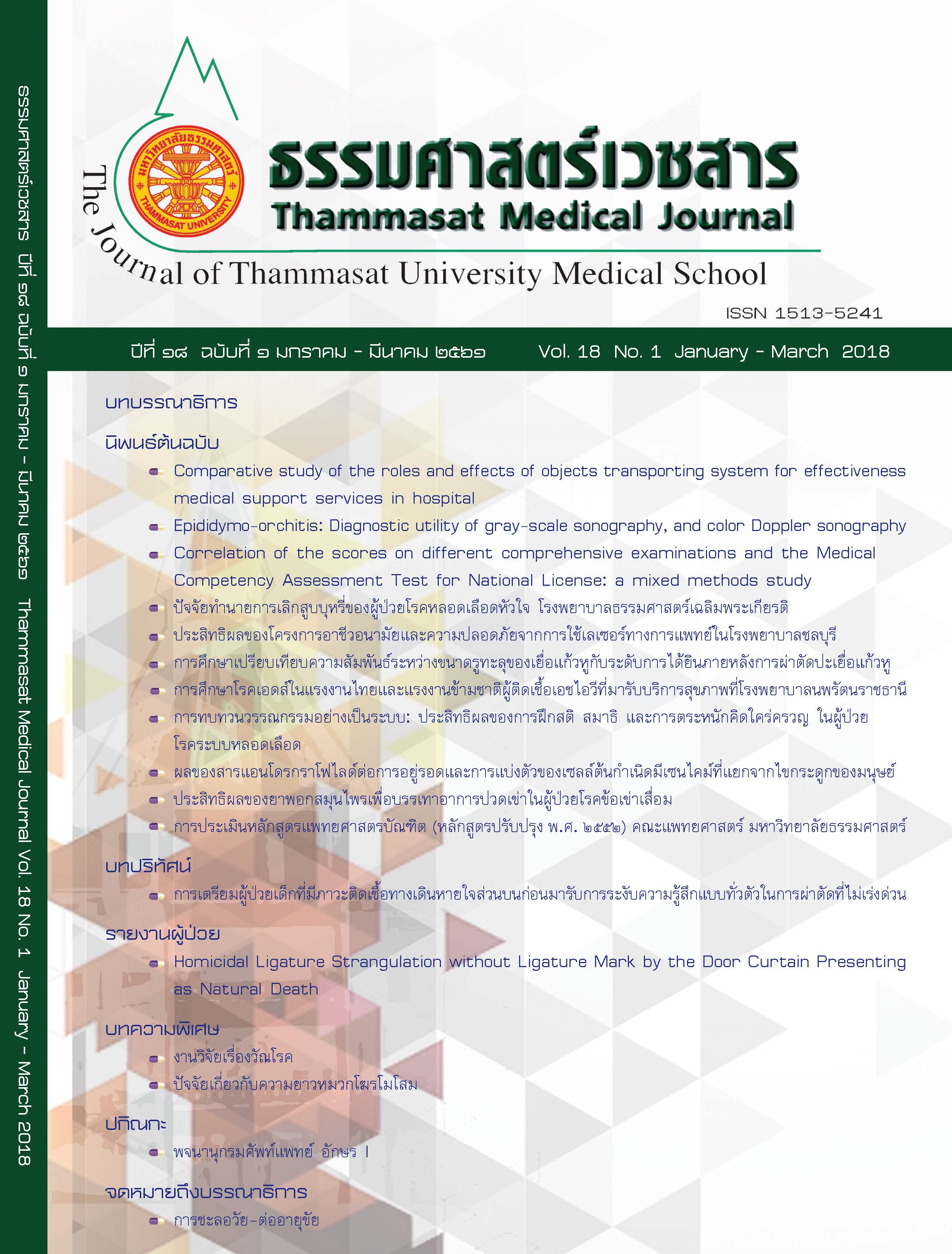Effect of Andrographolide on cell viability and proliferation of bone marrow-derived mesenchymal stem cells
Keywords:
Andrographolide, Bone marrow-derived MSCs, Cell viability, Cell proliferation, สารแอนโดรกราโฟไลด์, เซลล์ต้นกำเนิดมีเซนไคม์จากไขกระดูก, การอยู่รอดของเซลล์, การแบ่งตัวของเซลล์Abstract
Introduction: The reduction of Bone marrow-derived MSCs, BM-MSCs, is one factor that promotes osteopenia and osteoporosis in the Elderly (Age-related osteoporosis). BM-MSCs have been extensively studied in bone reconstruction and rehabilitation. However, the potential of BM-MSCs is reduced by the donor's age. In addition, the amount of MSCs received was small. Finding ways to increase cell numbers of BM-MSCs to enable bone cell development is an interesting alternative to bone regenerative medicine. Therefore, this study is interested in searching safe agents that enhance the BM-MSCs number. We test the effect of Andrographolide, the major compound of Andrographis paniculata (Burm. F) Nees, which there was no report of its effect on BM-hMSCs.
Method: BM-hMSCs isolated from bone marrow of healthy male and women volunteers were used in this study. Characterizations of BM-hMSCs were examined before using. BM-hMSCs were cultured in a growth medium. The effect of Andrographolide on cell viability was performed by incubating BM-hMSCs with 0.01-50 µM of Andrographolide for 24-72 hours. Cell viability was examined by MTT assay. The effect of Andrographolide on cell proliferation was further tested by incubating BM-hMSCs with 0.01-10 µM of Andrographolide for 24-72 hours. Cell proliferation was determined by BrdU assay.
Result: The isolated BM-hMSCs demonstrated the characteristics of MSCs that can be used for further study. After incubation with Andrigrapholide at concentrations of 0.01-50 µM for 24-72 hours, Andrographolide at 0.01-10 µM had no toxic to BM-hMSCs. Therefore, these concentrations were used for further experiments. In proliferation study, Andrographolide at 0.01-10 µM increased the BM-hMSCs after treatment for 24-72 h.
Discussion and conclusion: This study show for the first time on the proliferative effect of Andrographolide on BM-hMSCs. These results suggest that Andrographolide has the potential for further development as an alternative agent for increasing the number of stem cells that are isolated from bone marrow and/or other sources for using in therapeutic application of bone related diseases.
บทคัดย่อ
บทนำ: การลดลงของ Bone marrow-derived MSCs (BM-MSCs) เป็นปัจจัยหนึ่งที่ส่งเสริมให้เกิดภาวะกระดูกโปร่งบางและภาวะกระดูกพรุนในผู้สูงอายุ BM-MSCs ได้รับความสนใจศึกษาอย่างกว้างขวางในการฟื้นฟูและซ่อมแซมกระดูก แต่อย่างไรก็ตามศักยภาพของ BM-MSCs จะลดลงตามอายุของผู้บริจาค อีกทั้งปริมาณของ MSCs ที่แยกได้แต่ละครั้งได้จำนวนน้อย การหาวิธีเพื่อเพิ่มจำนวนเซลล์ให้มากขึ้นจึงจะเป็นทางเลือกที่น่าสนใจในการรักษาทางด้านเวชศาสตร์ฟื้นฟูด้านกระดูก ดังนั้นผู้วิจัยจึงมีความสนใจที่จะหาสารที่มีความปลอดภัยที่สามารถช่วยเพิ่มจำนวน BM-MSCs โดยศึกษาฤทธิ์ของสารแอนโดรกราโฟไลด์ (Andrographolide) จากสมุนไพรฟ้าทะลายโจร (Andrographis paniculata (Burm. f) Nees ต่อการอยู่รอดและการแบ่งตัวของ BM-hMSCs
วิธีการศึกษา: การวิจัยนี้ใช้ BM-hMSCs ซึ่งแยกสกัดจากไขกระดูกจากอาสาสมัครชายและหญิงที่มีสุขภาพดี และมีการตรวจสอบคุณลักษณะของ BM-hMSCs ก่อนนำมาใช้ศึกษา โดย BM-hMSCs ถูกเพาะเลี้ยงในอาหารชนิดกระตุ้นการเจริญเติบโต ทดสอบความเป็นพิษของสารแอนโดรกราโฟไลด์ต่อเซลล์โดยบ่มสารแอนโดรกราโฟไลด์กับ BM-hMSCs ที่ความเข้มข้น o.o๑-๕o ไมโครโมลาร์ เป็นเวลา ๒๔-๗๒ ชั่วโมง ก่อนนำไปทดสอบด้วยวิธี MTT assay ทดสอบผลของสารแอนโดรกราโฟไลด์ต่อการแบ่งจำนวนของ BM-hMSCs โดยบ่มสารแอนโดรกราโฟไลด์กับ BM-hMSCs ที่ความเข้มข้น o.o๑-๑o ไมโครโมลาร์ เป็นเวลา ๒๔-๗๒ ชั่วโมง ก่อนนำไปทดสอบด้วยวิธี BrdU assay
ผลการศึกษา: พบว่า BM-hMSCs ที่คัดแยกได้แสดงคุณสมบัติตรงตามข้อบ่งชี้ที่กำหนดโดย International Society for Cellular Therapy (ISCT) ซึ่งสามารถนำไปใช้ศึกษาต่อได้ ซึ่งภายหลังที่ BM-hMSCs ได้รับสารแอนโดรกราโฟไลด์ที่ความเข้มข้น o.o๑-๕o ไมโครโมลาร์ เป็นเวลา ๒๔-๗๒ ชั่วโมง พบว่าสารที่ความเข้มข้น o.o๑-๑o ไมโครโมลาร์ ไม่มีความเป็นพิษต่อ BM-hMSCs ในการทดสอบผลของสารแอนโดรกราโฟไลด์ต่อการแบ่งตัวเพิ่มจำนวนของ BM-hMSCs พบว่า สารที่ความเข้มข้น o.o๑-๑o ไมโครโมลาร์ มีผลเพิ่มการแบ่งตัวของ BM-hMSCs ในช่วงเวลา ๒๔-๗๒ ชั่วโมง
วิจารณ์ และสรุปผลการศึกษา: งานวิจัยชิ้นนี้เป็นการศึกษาแรกที่แสดงผลของสารแอนโดรกราโฟไลด์ต่อการเพิ่มจำนวนเซลล์ของ BM-hMSCs จากผลการศึกษานี้ชี้ให้เห็นว่าสารแอนโดรกราโฟไลด์มีศักยภาพที่จะพัฒนาต่อไปเป็นสารทางเลือกใหม่ เพื่อใช้ในการเพิ่มจำนวนของเซลล์ต้นกำเนิดชนิดมีเซนไคม์ที่แยกได้จากไขกระดูกหรือจากแหล่งอื่นได้ อันจะนำไปสู่การประยุกต์ใช้สำหรับการรักษาโรคที่เกี่ยวกับกระดูกในทางคลินิกต่อไป



